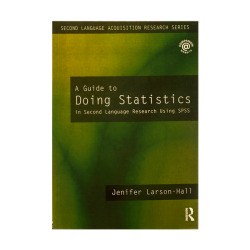Quantitative data analysis
Chapter 9
Quantitative data analysis
Book Name: Research Methods in Applied Linguistics
Writer: Zoltan Dornyei
Summarized: Saeed Mojarradi Ph.D. Candidate T.3
Saturday, October 6, 2018
Having collected quantitative data, the next step is to analyses it using a set of mathematical procedures, called ‘statistics’.
These range from simple descriptive statistics such as calculating the mean (i.e. the average) of the scores in a group to complex multivariate procedures such as structural equation modelling. The selection of the exact procedure will depend on the research question and the type of data collected, and once the analysis is completed the results will provide information on the basis of which we can answer the research questions and accept or reject the research hypotheses
We studied that quantitative analysis is more straightforward in this respect than qualitative analysis because here there are well defined procedures, guided by universally accepted canons, to address research issues and the computer will do most of the detailed mathematical work for us, producing relatively straightforward results.
Nowadays the mathematical aspects of quantitative data analysis are largely left to the computer, and several statistical programs have been developed to direct the computer’s work. These software packages have become increasingly user-friendly, to the extent that researchers do not need to have any mathematical training to use them and most of the procedures are fully interactive
There are many statistical packages on the market, and even spread such as Microsoft’s Excel can do a fair amount of statistics.
SPSS is not a beginners’ software package, yet it is appropriate for people who have little experience in statistics and programming because of its user-friendly interactive features. It has been around for over 35 years and therefore the current version (at the time of writing this, Version r 4) is highly refined and by and large bug-free. SPSS is easy to install and start. If you decide to use it in your research, you will need some sort of a guide or manual to help to run the software, although one can go a long way by simply relying on the software’s own ‘Help’ system.
Furthermore, because SPSS is being taught at so many universities, even a quick search on the Internet will result in a number of very useful online tutorials and user-friendly overviews. Because of the widespread use of SPSS, most of the serious academic publishers offer their own
Coding quantitative data
Quantitative data analysis software handles data in a numerical rather than an alphabetic form, and even though SPSS allows the of information recorded as letters (for example, words or proper names to) the procedures that are available for handling such textual data are limited compared to the vast arsenal of statistical techniques to be used with numerical responses.
There-fore, the first step of data processing involves converting the respondents’ answers to numbers by means of ‘coding procedures’. Because numbers are meaningless in themselves and are all too easy to mix up, a major element of the coding phase is to define each variable and then to compile coding speci-fications for every possible ‘value’ that the particular variable can take. (We should note here that ‘value’ is a technical term used in statistics, referring to the numbers assigned to the response options of the variable). For example, gender data is usually labelled ‘sex’ and it can take two numerical values: `male’ is usually coded `I’ and `female’ 2.’
Inputting the data
Entering the data into a computer file requires three steps: (I) creating the data file, (2) defining the coding frames for the variables, and (3) keying in the data.
Creating and naming the data file
Creating a new data file is easy in modern statistical software such as SPSS. However, the nature of data files is such that we regularly make changes in them during the process of data analysis (for example, recode variables or compute new composite variables) and one of the recurring problems I have encountered with novice (and not-so-novice) researchers is that multiple versions of the data files are stored next to each other, with the file names becoming confusing and the files getting mixed up. Furthermore, in most studies we are likely to return to the dataset at later stages, and without a foolproof naming/labelling system and a properly maintained research log (see Section 3.4.2) it might be a daunting task to sort out which file is what. Therefore, it is worth adopting the following filing process (though please consult an SPSS guide on how exactly to carry out the following steps):
1-Give the data file a simple generic name(for example, `Motivation_datal, ) to which SPSS will add the extension ,sav, whenever you make any changes in the data file, save the modified file under a new version name (for example, Notivation_data .sav’, `Motivation data 2..sav’, etc.).
2- The first version of the data file (`Motivation data .sav5) should be saved under the old file name because this would make it very difficult.
3- When we make any change in the data file, we need to have a permanent record of this change in the form of a ‘command file’, which in Spss is called “ syntax file “.
4-Name the syntax file that creates a new version of data file in a way that it corresponds to the newly created data file’s name. For example, the file that creates `Motivation_dataz.sav’ should be named Motivation_data2.sps,
5-If you follow this procedure consistently, you will always know which is the latest version of the data file the one with the highest version number and you can always trace back what has changed from one of corresponding syntax files.
Defining the coding frames
When the data file has been created and properly named, we need to decide on the ‘coding frames’ for all the variables.
The SPSS Data Editor screen has a data and a ‘variable’ view (indicated in the bottom left corner). In the `variable’ view we must first specify the name of each variable.



